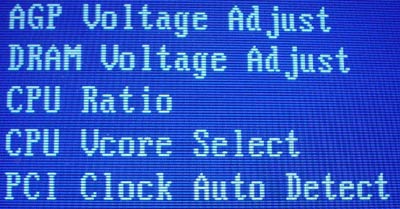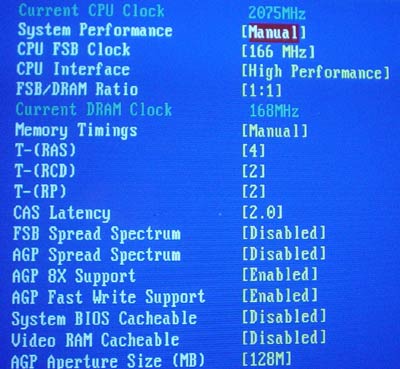nForce2 6-way Motherboard Roundup - December 2002
by Evan Lieb on December 4, 2002 6:53 PM EST- Posted in
- Motherboards
MSI K7N2-L: BIOS and Overclocking
MSI decided to use Phoenix Technology's Award BIOS for their nForce2 motherboard, and this certainly isn't bucking the trend, as all nForce2 motherboards use an Award BIOS.

BIOS hardware monitoring can be found in the PC Health section. In general, we see a fair amount of readings, ranging from system and CPU temperature, North Bridge and CPU fan speed, Vcore, PSU readings (all rails), battery voltage, and options for enabling or disabling CPU Warning Temperature and Warning Beep. All in all this is a very basic PC Health section. Worthy of note is the available North Bridge fan speed reading that is present, despite the fact that the North Bridge is passively cooled. Therefore, you should have no trouble replacing the passive North Bridge heatsink for an active cooling solution in the future.

The Advanced Chipset Features section contains options for adjusting a large array of things. In this section, you're allowed to adjust the CPU interface, memory dividers and various memory timings (including Active to Precharge, Precharge to Active, Active to CMD, and CAS latency). As with most of the other nForce2 BIOSes, the Precharge to Active and Active to CMD timings are adjustable from 1-7T, and Active to Precharge is adjustable from 1-15T. Though the Active to Precharge timing was the only timing able to take advantage of these abundant options, it's nice to have nonetheless.
The FSB options top out at 200MHz (1MHz increments) in the K7N2-L BIOS unfortunately. We hope to see an updated BIOS with higher FSB adjustments in the future simply due to the fact that some overclockers will want to run their 400MHz FSB Athlon XP Bartons higher than their stock FSB setting. For example, a 250MHz setting would be nice to see in a future K7N2-L BIOS update.

Voltage tweaking is made possible by the "Frequency/Voltage Control" section. In this section you'll find options for adjusting AGP up to 120MHz in 1MHz increments, VAGP, VDIMM, CPU multiplier, Vcore, and what appears to be a PCI lock control option (which we're not sure about yet).
There will be many users disappointed with the lack of flexible Vcore adjustment in this BIOS version. The max attainable Vcore via the K7N2-L BIOS is 1.80V, and what's even worse is that actual Thoroughbred-B Vcore fluctuates between 1.61-1.62V (instead of 1.65V). This means that consumers that planning on using their Palomino processors in the K7N2-L (and plan on doing some overclocking) will have to stay very near to the 1.75V spec of those CPU's. However, for Thoroughbred-A/B users, the actual attainable Vcore of 1.77V or so should be enough, though there will undoubtedly be some who won't be satisfied with 1.77V.
VDIMM adjustments weren't all that impressive either. You can "only" adjust VDIMM as high as 2.7V. Though having the potential to go any higher than 2.7V probably won't yield you a better memory overclock, it's still nice to have for some overclockers. We should remind you that running much higher than 2.8VDIMM is bad for the longevity of your memory.
We still haven't been able to get confirmation from MSI as to whether the K7N2-L locks the PCI bus at 33MHz. There is an AGP lock at 66MHz for this board (as with all nForce2 boards). We'll immediately update you with more information as we receive it from MSI. 12/04/02 UPDATE: MSI sends word that the K7N2-L indeed does not have a PCI bus lock at 33MHz, meaning you will overclock your PCI bus to a certain level at a certain overclocked FSB speed.
The MSI K7N2-L ended up performing in the middle of the pack as far as FSB overclocking was concerned. Here were our FSB overclocking results using the following setup:
|
Front Side Bus Overclocking Testbed |
|
|
Processor:
|
Athlon
XP 2400+
|
|
CPU
Vcore:
|
1.65V
|
|
Cooling:
|
AMD
Retail HSF & Thermal Pad
|
|
Power
Supply:
|
Enermax
300W
|
With this very common overclocking setup, we were able to hit 186MHz FSB, which was exactly what the ABIT NF7-S was able to achieve and 1MHz higher than the ASUS A7N8X. It's obvious that a good chunk of the nForce2 boards tested here today are limited to somewhere in the mid-180MHz FSB range, while only Epox's 8RDA+ and Chaintech's 7NJS are able to reliably operate at anything above that FSB range (190MHz and 194MHz respectively).
MSI includes some fairly limited multiplier options, ranging from just 7X to 13X in 0.5X increments. This will be a disadvantage to some power users, but should satisfy most overall. For our FSB tests, we lowered the multiplier to 8X. The MSI K7N2-L is yet another motherboard that is able to unlock factory locked Thoroughbred-B processors. Therefore, we were able to unlock our Athlon XP 2400+ with ease on the K7N2-L.










1 Comments
View All Comments
c627627 - Monday, July 21, 2003 - link
MSI contradicts your reviewhttp://www.anandtech.com/mb/showdoc.html?i=1759&am...
You say:
"12/04/02 UPDATE: MSI sends word that the K7N2-L indeed does not have a PCI bus lock at 33MHz."
To this day, that was used as ultimate proof that the original MSI nForce2 mobo does not have a PCI lock.
Today MSI Senior Moderators said:
"they are wrong,and who ever told them it did not from msi"
(!)
Source:
http://www.msi.com.tw/program/e_service/forum/thre...
Won't you please settle this for us.